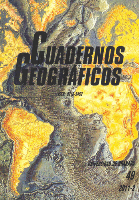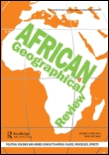
Journal of Geology Geography and Geoecology
Scope & Guideline
Advancing Knowledge in Geology, Geography, and Geoecology.
Introduction
Aims and Scopes
- Geological Studies:
Research on geological formations, mineral deposits, and tectonic processes, including the study of specific regions such as the Lesser Caucasus and the Carpathians. - Geoecology:
Analysis of the ecological impacts of geological processes and human activities, emphasizing the importance of sustainable practices in managing natural resources. - Geographical Information Systems (GIS) and Remote Sensing:
Application of advanced technologies for spatial analysis, mapping, and assessment of various environmental phenomena, including land use changes and natural hazards. - Environmental Assessment and Management:
Studies focusing on assessing environmental quality, impacts of pollution, and the management of natural resources to promote sustainability. - Tourism and Recreation Geography:
Exploration of the potential for tourism development, including ecotourism and cultural tourism, with a focus on preserving natural and historical heritage. - Hydrology and Water Quality Studies:
Research on water resources, including groundwater quality assessments and the impact of human activities on aquatic ecosystems. - Climate Change Impacts:
Investigations into how climate change affects geological and ecological systems, including studies on temperature and precipitation projections.
Trending and Emerging
- Sustainable Development and Eco-Tourism:
An increasing number of studies focus on sustainable tourism practices, emphasizing the balance between tourism development and ecological preservation. - Climate Change Adaptation and Mitigation:
Research addressing the impacts of climate change, including hydrological studies and assessments of ecological resilience, has gained prominence in recent publications. - Geospatial Analysis and Technology Integration:
There is a notable rise in the use of GIS and remote sensing technologies for various applications, including environmental monitoring and land use planning. - Socio-Ecological Systems:
Emerging studies that examine the interplay between social systems and ecological environments are becoming more prevalent, reflecting a holistic approach to geography and ecology. - Impact of Anthropogenic Activities:
Research exploring the effects of human activities, such as urbanization and industrialization, on geological and ecological systems is trending, highlighting the need for integrated management strategies.
Declining or Waning
- Traditional Geological Surveys:
The emphasis on classic geological surveys and studies is waning as more interdisciplinary approaches and technologies like GIS and remote sensing gain traction. - Mining and Resource Extraction Studies:
While still relevant, the frequency of studies solely focused on mining impacts has decreased, possibly due to a broader shift towards sustainability and ecological considerations. - Paleontological Studies:
The number of papers dedicated to paleontological research appears to be declining, indicating a potential shift towards more contemporary geological and ecological issues. - Urban Geography without Ecological Context:
Research focusing exclusively on urban geography is less common, as there is a growing integration of ecological and environmental considerations into urban studies.
Similar Journals

Cuadernos Geograficos
Unlocking insights into our dynamic earth-surface processes.Cuadernos Geograficos is a distinguished open access journal published by UNIV GRANADA in Spain, dedicated to advancing the fields of geography, planning, and earth-surface processes. With an ISSN of 0210-5462 and E-ISSN 2340-0129, this journal has been serving as an essential platform for scholars since its inception in 1983. By providing rigorous peer-reviewed research, Cuadernos Geograficos contributes significantly to the academic discourse within these disciplines, holding a respectable position in the Q3 category for both Earth-Surface Processes and Geography, Planning, and Development as of 2023. The journal is indexed in Scopus, ranking #431/821 in Social Sciences and #100/179 in Earth and Planetary Sciences, affirming its relevance and impact within the scholarly community. With its commitment to open access since 1999, Cuadernos Geograficos ensures that vital research is accessible to a diverse audience of researchers, professionals, and students, fostering knowledge sharing and collaborative advancements in the geographical sciences.

Hungarian Geographical Bulletin
Exploring the intersections of geography, culture, and agronomy.Hungarian Geographical Bulletin, with ISSN 2064-5031 and E-ISSN 2064-5147, is a premier open-access journal published by the CSFK GEOGRAPHICAL INSTITUTE that has been an influential resource since 2009, dedicated to advancing the fields of geography, cultural studies, and agronomy. Located in Budapest, Hungary, this journal aims to disseminate high-quality research and engage a diverse audience of researchers, professionals, and students. The journal's reputation is underscored by its impressive category quartiles in 2023, ranking Q2 in Agronomy and Crop Science, Q1 in Cultural Studies, and Q2 across several other areas, including Geography and Earth and Planetary Sciences. With a Scopus ranking that places it in the top percentiles in multiple fields, the Hungarian Geographical Bulletin serves as an essential platform for innovative ideas and discussions that drive geographical scholarship and practice forward, specifically during its converged years from 2014 to 2024. Whether you are a seasoned researcher or an enthusiastic student, this journal presents a wealth of knowledge that is easily accessible due to its open-access format.

Physio-Geo
Empowering Insights into Earth-Surface ProcessesPhysio-Geo (ISSN: 1958-573X) is a distinguished open-access journal published by REVUES ORG, dedicated to advancing the fields of Earth and Planetary Sciences, with a special focus on Earth-Surface Processes, Environmental Science, and Ecology. Since its inception in 2007, Physio-Geo has provided a platform for researchers, professionals, and students to disseminate and access high-quality studies that contribute to the understanding of our environment. With a convergence period from 2019 to 2024, the journal aims to bridge disciplinary gaps and foster interdisciplinary research that addresses pressing ecological and environmental challenges. Despite its current Scopus rankings reflecting an early-stage development, the journal is poised to enhance its impact within the scientific community, particularly as it embraces a wider audience through its open-access model. By offering valuable insights and comprehensive analyses, Physio-Geo is an essential resource for those seeking to explore the complex interactions between physical geography and ecological systems.

JOURNAL OF THE GEOLOGICAL SOCIETY OF INDIA
Advancing geological knowledge, one study at a time.JOURNAL OF THE GEOLOGICAL SOCIETY OF INDIA, published by Springer India, serves as a pivotal platform for researchers and practitioners in the field of geology. Established in 1979, this journal has been instrumental in advancing geological research throughout India, showcasing both regional studies and cutting-edge global research. With its Category Quartile ranking of Q3 in the geology category for 2023, and a significant Scopus rank of 171 among 321 journals in Earth and Planetary Sciences, it remains a respected source of scholarly activity. The journal is dedicated to the dissemination of original research articles, reviews, and case studies that encapsulate the dynamic scope of geological science, thus contributing to the understanding of geological phenomena. Although currently not offering open access, the journal maintains a commitment to high-quality scholarship and aims to engage a diverse readership, enhancing the knowledge and practice of geology across various disciplines.

Quaestiones Geographicae
Innovating Insights in Earth and Planetary SciencesQuaestiones Geographicae, an esteemed open-access journal published by SCIENDO, serves as a vital platform for scholarly communication in the field of Earth and Planetary Sciences. Since its inception in 1979, the journal has been dedicated to promoting rigorous research and discourse in geography, encompassing a breadth of topics that reflect the dynamic nature of the discipline. With an impressive Impact Factor belonging to the Q3 quartile category, the journal actively contributes to the global scientific community's understanding of geographical phenomena. Its commitment to open-access publishing since 2010 ensures that groundbreaking research is accessible to a wider audience, facilitating collaboration and innovation. As part of its enduring legacy, Quaestiones Geographicae engages researchers, professionals, and students alike, inviting them to explore, share, and expand the boundaries of geographical knowledge.

Geographica Pannonica
Championing Open Access for Geographical ExcellenceGeographica Pannonica is a premier, open-access journal dedicated to the various dimensions of geography, atmospheric sciences, geology, and related fields. Published by the University of Novi Sad's Faculty of Natural Sciences and Mathematics, this Serbian journal has been a vital platform for scholarly discourse since its inception, with an open-access policy established in 2010 to enhance the dissemination of research findings. Covering a spectrum of topics from Earth-surface processes to tourism management, the journal has achieved notable rankings, reflecting its commitment to impactful research—ranking in the Q3 quartile across multiple categories in 2023. Researchers, professionals, and students are encouraged to engage with the latest articles that contribute to advancing our understanding of geographical phenomena and sustainability challenges, making Geographica Pannonica an essential resource for the global academic community.

Journal of Geography-Chigaku Zasshi
Innovating Research to Illuminate Global ChallengesJournal of Geography - Chigaku Zasshi is a distinguished publication that serves as a crucial platform for the dissemination of research in the realm of geography and earth sciences. Published by the TOKYO GEOGRAPHICAL SOC in Japan, this journal is indexed with an ISSN of 0022-135X and an E-ISSN of 1884-0884. With a scope that includes Earth-Surface Processes, Geography, Planning and Development, Geology, Geophysics, and Global and Planetary Change, it provides comprehensive coverage of pressing geographical issues. Although it holds a Q4 ranking in multiple categories as of 2023, the journal presents an opportunity for researchers, professionals, and students to contribute meaningful findings in a diverse and competitive landscape. The Journal of Geography actively promotes scholarly dialogue by embracing the complexities of our planet and encouraging innovative approaches to geographical inquiries. This open-access journal aspires to bridge gaps and foster collaboration among scholars worldwide, underscoring its importance in understanding and addressing contemporary geographic challenges.

Boletin de la Asociacion de Geografos Espanoles
Championing open access to vital geographical knowledge.Boletin de la Asociacion de Geografos Espanoles is a leading open-access journal dedicated to advancing knowledge in the fields of geography, urban studies, and environmental science. Published by the ASOCIACION ESPANOLES DE GEOGRAFIA, this esteemed journal has been a vital platform for geographers and researchers since 1984, facilitating the dissemination of high-quality research and insights. With an ISSN of 0212-9426 and E-ISSN of 2605-3322, the journal has been recognized for its contributions, currently ranking in Q3 in Earth-Surface Processes, Environmental Science, and Geography, Planning and Development, as well as Q2 in Urban Studies for 2023. The journal’s accessibility ensures a broad audience reach, supporting the engagement of researchers and professionals alike. Located in Madrid, Spain, and publishing from 2006 to 2024, the Boletin de la Asociacion de Geografos Espanoles stands as an essential resource for those invested in the geographical sciences and related disciplines.

African Geographical Review
Illuminating the Intersections of Geography and Development in AfricaAfrican Geographical Review is a pivotal academic journal published by Routledge Journals, Taylor & Francis Ltd, whose mission is to advance knowledge and understanding of geographical dynamics across the African continent. With an ISSN of 1937-6812 and an E-ISSN of 2163-2642, this journal consistently delivers high-quality research, showcasing innovative perspectives and interdisciplinary approaches within the fields of Earth-Surface Processes and Geography, Planning and Development. Recognized in 2023 with a Q2 ranking in these categories, it ranks #231 out of 821 in Social Sciences and #63 out of 179 in Earth and Planetary Sciences according to Scopus metrics, reflecting its substantial impact and relevance. Featuring research that spans various geographic themes, the journal not only champions academic inquiry but also fosters a deeper understanding of spatial and environmental challenges unique to Africa. Engaging with a diverse audience of researchers, professionals, and students, the African Geographical Review serves as an indispensable resource for those committed to enhancing geographic scholarship and informing sustainable development practices across the continent.

AIMS Geosciences
Advancing Earth Sciences through Open AccessAIMS Geosciences, published by the American Institute of Mathematical Sciences (AIMS), is an esteemed open-access journal that has been serving the geosciences community since its inception in 2015. With an ISSN of 2471-2132, the journal disseminates high-quality research pertaining to various disciplines within geosciences, including geology, meteorology, oceanography, and environmental science. By promoting freely accessible research findings, AIMS Geosciences aims to foster collaboration and innovation among researchers, professionals, and students alike. The journal upholds rigorous peer-review standards, ensuring that only the most impactful research is shared with the global academic community. Situated at the forefront of geoscientific inquiry, this journal not only enhances the visibility of cutting-edge research but also contributes significantly to the understanding of Earth's processes, making it an essential resource for anyone engaged in this vital field.